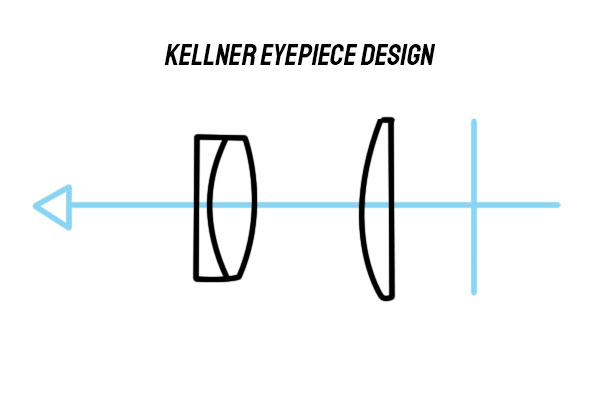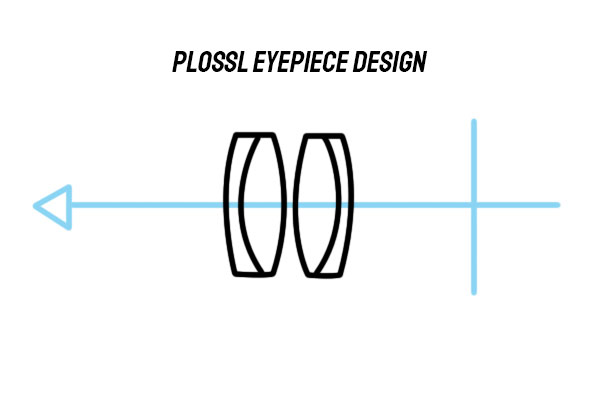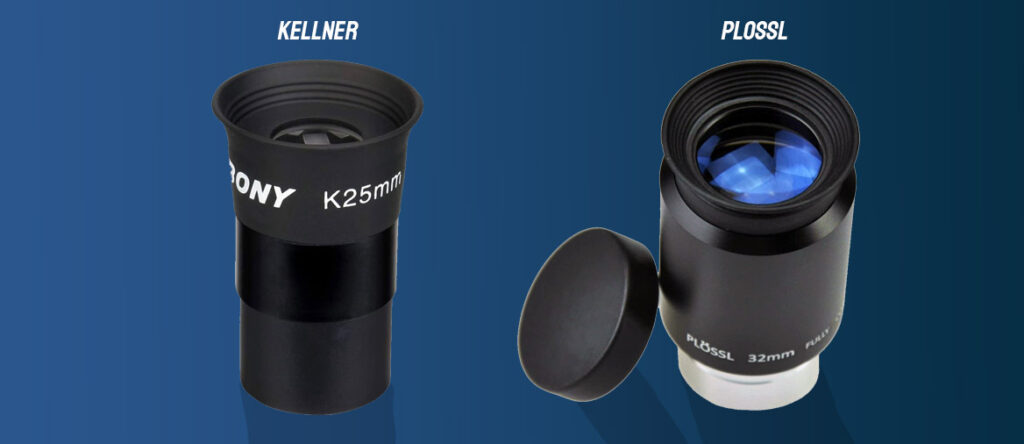Eyepieces have evolved a lot throughout the last couple of centuries. Astronomers and companies have come up with dozens of different designs and types of eyepieces to meet different needs. Some are built for better performance, some are made to reduce optical errors, and some have been designed to be cheap, making them accessible to everyone.
Most of those designs are now outdated. When it comes to modern telescopes, you will mostly hear about 4 or 5 designs that have stood the test of time. Among this group, Plossl and Kellner eyepieces are the most popular ones for astronomy enthusiasts.
But what are the similarities and differences between Plossl and Kellner eyepieces? Is one better than the other? Let’s answer those questions.
Kellner eyepiece design

The mechanic Karl Kellner created this eyepiece design in 1849. His objective was to create the first functional achromatic eyepiece to minimize spherical, and chromatic optical aberrations, which were some of the main issues previous eyepiece types had at the time.
Kellner eyepieces feature a design with 3 lenses cemented together. This reduces chromatic (color) issues but comes at the expense of a narrow field of view.
The field of view of a Kellner can go from 35 to 50 degrees.
The field of view is the maximum observable area that you can really see through your device. The rest of your image is black lines. Think of it as the black lines on a tv when the aspect ratio doesn’t match the image.
Plossl eyepiece design

A few years after the invention of the Kellner eyepiece, the Austrian inventor Simon Plössl tried to improve on it and came up with his own design. The Plossl eyepieces also use achromatic lenses but contains four instead of three. These 4 lenses are paired in two doublets aligned symmetrically. This is why Plossls are also sometimes known as symmetrical eyepieces.
Plossl eyepieces have a wider field of view that can go from 50 to 56 degrees. They also improve a bit when it comes to eye relief. The eye relief is the distance between your eyes and the eyepiece where you are able to view the whole image comfortably. An eye relief that is too low can be uncomfortable for the eyes, and hard to use for people with glasses. Both Plossl and Kellner have trouble with eye relief when it comes to high-powered eyepieces (below 10mm), but Plossls are slightly better.
Plossls can also offer better performance when it comes to reducing optical error and delivering brighter colors.
Due to the additional pieces and additional complexity in the manufacturing process, Plossls are slightly more expensive than Kellners but they are still accessible enough to have become the most popular type of eyepiece for amateur astronomers.
Kellner vs Plossl differences.
The following table shows the main differences, advantages, and disadvantages of both types of eyepieces.
| Kellner | Plossl | |
| Number of lenses | 3 | 4 |
| Lens type | achromatic | achromatic |
| Field of view | 35°-50° | 50°-56° |
| Eye relief | 13mm at focal length = 28mm | 20mm at focal length = 28mm |
| Price | $ | $$ |
The verdict. Which one is better?

In short, Plossl eyepieces are generally better than Kellner eyepieces, but they also tend to be more expensive.
The one caveat to this is that Plossls, because of their increased complexity, also have a wider spectrum of possible quality. There are good Plossl eyepieces, and there are bad Plossl eyepieces that can turn out to be worse than a Kellner. This quality is going to depend on the brand and model so you have to be more careful about choosing a cheap, generic eyepiece. Kellners in general are all going to be pretty close to each other in terms of quality so there’s little chance you will get much variance in image definition between brands.
If you are completely new to stargazing, Kellner eyepieces are absolutely fine. You will not be able to tell the difference between a comparable Kellner and a Plossl with similar specs, but as you gain experience, you will start noticing the subtle differences and you will probably outgrow the Kellners. At that point, you will probably want to move to Plossl, or even higher quality eyepieces, which means that you will end up spending money twice.
If you are buying your first telescope, and you are choosing between one that includes one or the other with all the other specs being similar, pick the one with the Plossl, even if it’s slightly more expensive. As long as you take good care of them, they can last you a lifetime, and you will be able to use them with your next telescope if you upgrade at some point. They will be the start of a collection of eyepieces instead of just temporary accessories.
That doesn’t mean Kellner eyepieces aren’t bad. If your main consideration is price, and you are getting a great deal or a discount on a telescope that includes a pair of these, they are perfectly serviceable and they will help you learn.
Summary
- Plossl eyepieces have a slightly more advanced design and better features
- Kellner eyepieces are more affordable
- If you can choose, go with the Plossl. They are the most cost-effective purchase long-term
Enjoyed this article?
Get daily 10-minute PDFs about astronomy to read before bed!
Sign up for our upcoming micro-learning service where you will learn something new about space and beyond every day while winding down.







